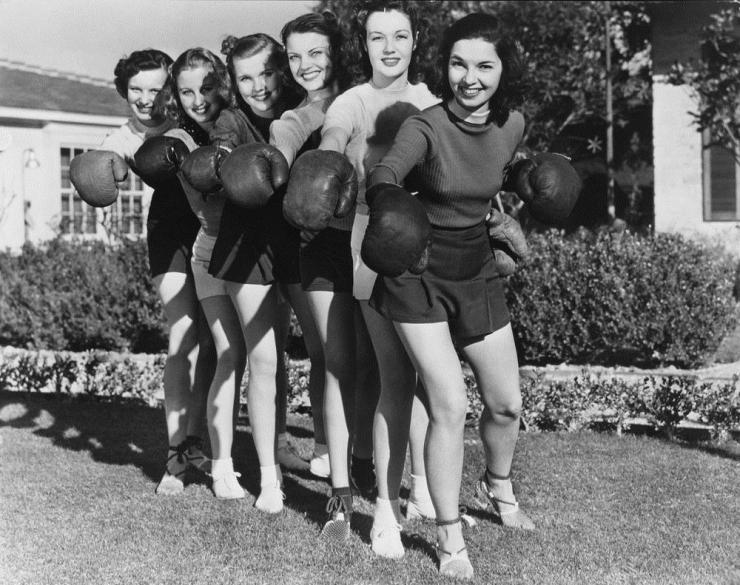Submitting Like A Man
Submitting Like A Woman
This is the eighth installment of the blog series Submitting Like A Man (SLAM), created by writer Mya Kagan. The project examines what happens when Mya resubmits scripts to previously rejected opportunities, this time using a man’s name. For more on SLAM, check out submittinglikeaman.com or follow @theSLAMblog or @Mya_Mya.
Regular readers of Submitting Like A Man (lookin’ at you, mom!) will know my oft-quoted statistic: that 51 percent of the population in the US is women, but only about 20 percent of our writers in theatre and TV are female. It’s a statistic that's been shown by numerous data collecting initiatives (such as here, here, and here) and as something that's fairly straightforward to calculate, the number itself is not something most people I've encountered are highly contesting; in fact, if anything, it's something far too many of us accept as believable/normal.
What I ultimately can't help but wonder is if it even makes any difference for women to submit in smaller numbers than men. And if it is true that women are submitting less, is it still "fair" for us to expect to be half the resulting productions?
It’s the sort of discrepancy that’s so entrenched in the workings of our industry, the story of our history, and the behaviors of our society that it can’t be pinned on one singular cause. Discrimination of any kind is a multifaceted problem, which is why it's so damn hard to stop or change. SLAM is a project I created to examine the part of the discrepancy stemming from unintentional bias. And there are all kinds of other factors that are almost certainly weaving together and causing the discrepancy too—producers who don't believe women's stories will sell, awards shows that are rewarding the same white male old-guard over and over again, and so on.
But recently it was brought to my attention that there’s another factor in the mix when it comes to the under-representation of women writers in the entertainment industry: It seems that in some cases, fewer women writers are submitting work, with some instances showing as few as 25 percent of submissions from women.
It’s the sort of problem that at first glance seems to imply we, lady playwrights, are somehow at fault for this large, looming problem. And if the numbers are correct, I definitely think we could stand to do better; it certainly would not hurt to be half the submission pool. But the problem we’re facing started before anyone reading this would have even been born, and it’s so complicated and layered that there’s no way we can wag a finger at lady playwrights and call off the investigation. There are many reasons why we would be remiss to say that women making up half the applicants would solve the problem, not the least of which is because submissions and open calls for work are just one of many ways new writers and new scripts are discovered, developed, and produced. But as someone administering a gender bias project that utilizes the submission process, I can't help but wonder what’s going on.
Female playwrights, and our plays, most certainly exist (I swear I’m not a hologram). So why are we seemingly submitting so much less? It’s one of these things that’s impossible to “know” (again: if we could, it would be easy to solve) and that other women and organizations have pondered before me—which, in fact, is how I came to be aware of it. And since launching this project, I've had many people tell me that they don't think I’m submitting enough. I’ve publicly stated that in the last nine years, I’ve sent out 117 submissions. To me, the number is a Goldilocks-esque “just right,” but others have suggested that perhaps I am “submitting like a woman” by simply not submitting enough. (What's tricky about that idea is that I've had many of those same people remark that my success rate—about 10 percent of submitted work has been accepted—is higher than most. I can't say if that’s true or not because most writers I know will guesstimate their success rate but actually don't keep track closely enough to calculate an actual number.)
What I ultimately can't help but wonder is if it even makes any difference for women to submit in smaller numbers than men. And if it is true that women are submitting less, is it still "fair" for us to expect to be half the resulting productions? Let's say a play festival is producing ten pieces. In a perfectly “equal” world, there would be five plays written by women, and five by men. So let’s say their applicant pool is all comparable quality work, and breaks down to 30 percent women and 70 percent men. Does that mean they choose three female winners and seven male? Or are they still obligated to choose five and five? My personal answer is five and five, but I can certainly see how others may argue that's unfair or nonsensical.
In essence, it's a philosophical question. Do we choose and present work representative of the applicant pool's demographics? Do we choose work that doesn't necessarily reflect the demographics of those who have submitted but does represent the demographics of our society? Or since this is art, do we have an obligation to put aside the composition of the applicant pool and make a deliberate effort to choose work that promotes voices that have historically been under-represented, oppressed, and/or denied opportunity? The only answer I have is that, as with so many issues we face as a society, what we need is an all around awareness, cooperation, and a commitment to figuring it out together. And my hunch is that if we work together to give more women the opportunity to succeed, more women will come forward to put their hats in the ring.











Comments
The article is just the start of the conversation—we want to know what you think about this subject, too! HowlRound is a space for knowledge-sharing, and we welcome spirited, thoughtful, and on-topic dialogue. Find our full comments policy here
I wonder now, and have wondered for years, what would happen if the work were submitted without names attached. No one would know age, race, gender, etc. of the person submitting, so the work would be judged solely based on its contents. Would it even out? Are the biases so deeply ingrained that the dialectical difference between a white female writer of 50 and a white male writer of 50 would cause the judgement to sway in favor of the man because it's what more often chosen?
The practice of blind auditions famously worked wonders for gender parity among orchestra musicians: http://bit.ly/1pqy6OZ. It's my belief it would do the same for theatre.
(More about my thoughts on blind submissions also here: http://bit.ly/1URkBEB.)
There's a similar dynamic at work in fiction. Here's a good article published yesterday: http://www.themarysue.com/w...
Thanks, great article!
Thanks for doing this series. Really shows some stuff in black and white. Appreciate the research.
And now to some critical responses after reading this and scanning the first installments for where the focus of my response will go.
I'm chiming in as a male ally, after working with, living with and talking care of Judith Malina for the last ten years of her life. I think that context is important for the content of my response. And being from The Living Theatre, I am sending it as part of a deep search for answers to these questions.
So, I'm finding myself engaged in equity discussions of all kinds, racial, gender identity (not so side, side note: 5/5 is not an equal gender distribution when you factor in non binary folks, but maybe you already addressed that in an earlier post)...
...but as I engage in equity discussions, I find I am a broken record.
The real solutions lie in really not fun, and immediately low impact work, like finding after school programs and encouraging elementary, junior high and high school level females and encouraging them towards more career paths.
It means going to colleges where the female population is trapped in too few majors and encouraging them to open up to playwrighting. It means offering beginners playwrighting workshops to schools and being happy when one person shows up after the 5th try.
It means when your plays are produced, scouring the audience for young women, talking to them, and making sure there is a diverse population of them present to see your work, and then making it incredibly transparent how to be in touch with you and offering advice, guidance and support.
When I see someone write something like opportunities "that advance my career" I worry that they are not actually interested in solving the systematic problem, but more interested in venting about their personal frustration.
While this may not be true about you, I don't know you personally...this mentality is a big problem in our field, where advocacy work suffers from lack of participation as the work does very little to immediately advance any one person's individual career.
I say this all because I lived with Judith and that's where it led me after learning from her about her struggle trying to be one of the first female directors and playwrights and company leaders while creating the off broadway movement.
Her teacher said to her when she asked to be in the directing program in 1945, "you should be an actress...it takes real commitment to be a director, and once you get pregnant you will abandon your directing responsibilities..."
I mention this because Judith then devoted her career to international issues of inequity and speaking out for unheard voices, even in politicaly and personally dangerous situations, doing work with poor brazilian children in favelas under the military dictatorship there, getting arrested and thrown in torture prison, and rejecting several broadway offers that would have furthered her career but compromised her mission.
I apologize if this seems somewhat blunt, and I'm sorry if maybe you address some of these issues in your work somewhere...I didn't see it as I skimmed the previous installments.
I worry about everyone's earnestness in actually engaging on the levels that are required to do this work in increasing equity, and the comment you made here that I quoted hurts me every time I hear it. Actually it's a very male thing to say in this patriarchal capitalist society. And stunning how much it carries through the arts.
Hi Brad. Thank you for sharing your thoughts. These are all very valid concerns and questions, and I appreciate that you raised them.
I fully agree that a lot of the work to be done starts with the difficult work on nurturing young new artists. It's partially for that very reason that I have spent the last 10 years working as a teaching artist and mentor, in addition to freelance writing and other miscellaneous day jobs. I am very committed to helping young people, and especially young girls, find a place for themselves in the arts.
That being said, it's important to know that study after study has shown that women have or surpass parity in theatre all the way up to and until the end of college, meaning that half or more of the degrees and/or productions at that stage are going to women. And then, something happens. Women stop being produced as much, and they stop submitting as much (not necessarily in that order -- chicken and the egg, if you will). So while starting at the beginning and nurturing young artists is crucial, there's also something else going on, after all that nurturing is done, which needs to be addressed. And that's what I'm trying to examine with this project.
And I apologize if my phrasing in the comments about being interesting in opportunities that would "further my career" gave you the impression that I am not interesting in solving a larger problem. The phrase "furthering my career" was only my short way of referring to opportunities that will help me accomplish the larger goals that I am pursuing as an artist. Some of those goals are related to my own writing, and some are related to solving the larger parity problem. For me, something that "furthers my career" can be something that helps me with one, the other, or both.
Also, I do agree about the metaphor in my article of 5 female/5 male being imperfect, as you are correct that it does not account for non-binary folks. It is something I did try to include in the metaphor, but with only about 800 words per post, it was among the many things that I had to cut. (This post required me to do far more cutting than most of my articles, and could easily have been two or even three posts.) I do realize that a metaphor that uses only female/male is an oversimplification of the real world, and I appreciate you addressing that.
Thank you again for the thoughtfulness of your response and for raising these questions. I appreciate your support of this project and larger efforts of gender parity. Thank you for also sharing your experiences of living and working with Judith Malina. I hope I have helped clarify things in regards to your concerns and am glad that you reached out.
Chiming in! I like Brad's suggestion, but I agree with you Mya that the gender disparity certainly doesn't seem to be happening in middle and high school, and I didn't find it much in college either.
I do playwriting workshops for middle and high school kids all over the country - I've probably visited 80 schools in 20 states by now, and I am struck by how many young women are interested in playwriting. In fact, rather than a 50/50 distribution, I'd say there are far more young women interested in playwriting than young men. (There are more girls in general in theatre than boys - talk to any middle school theatre teacher and they'll tell you the ratio is something like 80/20 - the numbers start moving towards more equality in high school, but schools in general are doing a very good job getting girls interested in theatre.)
Which is why it's such a shame that there are fewer parts written for them in the canon, but that's another question.
What we should be looking at is when the women start dropping out. What is it that's causing them not to write, or not to submit their work? I taught playwriting in college as well, and my classes were more even than the high schools I visit, but they still tend to be majority female.
I honestly don't have any answers. I assume it's probably the convergence of a number of factors, but I honestly have no idea. I've made it a goal in my career to encourage young women to write and send their work out - thinking that perhaps a lack of mentors might be behind some of it.
But I agree that it's not enough for a theatre to throw up their hands and say, "well, we got 75% submissions from men, I guess our season will be 75% male-written." The reasons the submissions are not equal are rooted in a large number of factors in our society, and we have a responsibility to try to fight for some kind of parity if we want the theatre to flourish.
Thanks Don. My experience with students has been the same as yours. Consistently more girls enrolling in theatre or playwriting classes than boys. (In this entire school year, I've had exactly 3 boys in my drama classes. The number of girls is somewhere closer to 20-25. This is a typical distribution for my classes.)
It seems to me that somewhere after school ends, there is a combination of factors weaving together: Women are facing unintentional bias, they are becoming discouraged, and so on. I think you are right that theatres can't just throw up their hands if they get mostly male submissions and produce mostly male seasons. If there are opportunities for women to succeed, they will be more likely to submit themselves for consideration. And vice verse.
Thanks Mya. Could you shoot me some links to some of those studies, I'd love to have them on hand. As a new artistic director, of a collective company, we don't really do, or haven't figured out a way to work play submissions into our work flow yet as we figure ourselves out, but that information would be very helpful.
Glad to hear you are a teaching artist as well, jeez its important, and not enough folks do it!
Hey Brad. If you message me through my website (https://submittinglikeaman.... and send me your contact info, I'll send you a study to reference the next time I read one.
I'm with Adam in saying that at 10% acceptance rate is great. And 117 submission in 9 years seems pretty low. I like Adam's suggestion of 100/year. That's what I shoot for, too, but lately I've been at closer to 150 (my acceptance rate runs 10%-17). I post a lot about my writing numbers (and others) on my blog: http://writinglife3.blogspo...
I think you raise a very important question around parity and the pool. I think there are many efforts that need to be made in order to achieve gender parity in terms of plays produced, but definitely one of the most important steps is to get more women submitting to opportunities and get the pool of new work to include a lot more plays by women. At the very least, it takes away a standard excuse used by companies as to why they aren't producing more plays by women.
Thanks Patrick. I agree it would be great to have more parity in the pool of work. I think it's a bit of a chicken and the egg dilemma -- I think if women see their peers having success, they will be more likely to submit themselves for consideration. So one of those two things has to come first, but it's hard to have one without the other.
For my own submission rate, carefully picking a smaller number of opportunities that I am well-suited for has worked better for me than submitting to many things just to put a lot of work out there. I think everyone has their own approach, and it's interesting to see how that can break down by gender and/or affect a success rate.
I think you're right about the chicken/egg problem, which is why I'd advocate for a two-pronged approach. First, encourage more women to submit more plays. Second, get theaters to not just produce more plays by women, but also get them to actively reach out to female playwrights. I've worked with one theater development group who made proactive efforts to increase their pool--making sure they're putting out their calls for scripts to places like ICWP, reaching out to specific women writers to apply, and to ask women to spread actively spread the word about the submission opportunity to their peers. And it worked. It takes effort and commitment, but it can have a concrete impact.
Definitely, yes! Sounds like the group you worked with had a great approach. Effort and commitment are needed for sure. Hopefully more will catch on soon. Thanks Patrick.
I tell playwrights to try to submit 100 a year. This is harder than it used to be because more doors are closed now. I agree with those that tell you 10 percent success is really good. 5 percent is really good. 10 percent is amazing.
Thanks Adam. I would love to submit 100/year, but I agree more doors are
closed now. For me, I also prefer to submit primarily to opportunities
that I feel will really further my
career or to places that I know have a history of producing work that
matches the style of what I write, and there aren't enough of those for
me to do 100/year. It means submitting less in quantity, but to more
carefully selected opportunities. I don't know if it has affected the
success rate, but it's the method that has really worked well for me
over time. Thanks for your support.
Well congrats. It seems like it has worked. The thing I do (or have done. It's been a while) is reach out to independent theaters doing new work I think is like mine. I find a play like my play that isn't incredibly famous but is getting done and I do a google search and see who is doing it and then I approach those theaters over email. The success rate is better because it's not from a call. O'Neill had 1500 submissions this year. But small theater in small city doesn't. And if they're excited about new work like yours it may be more rewarding in some ways. My 2 cents. It won't help with your blog project but something maybe to try.
I think that's a great approach. A small theatre in a small city is also more likely to curate a long-term relationship, which can be better than being a flash in the pan at a big name opportunity. Someone once gave me similar advice to nurture relationships with five theatres who are always excited to read your newest play. Good luck to you as well and thanks again for your good wishes and support.